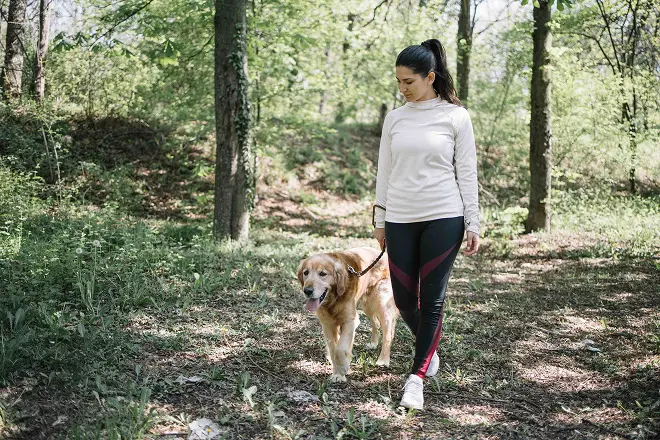For the Purrbabies


Make your walks safer and more enjoyable with these tips for heel position training.

Heeling refers to when a dog walks calmly and closely by your side, without wandering off or tugging at the leash. While traditional heeling involves matching your dog’s pace and movements precisely, the term has evolved to embrace a more relaxed approach known as “loose leash walking.” In both cases, the goal is a stress-free stroll, making walks more fun for both you and your pup.
Teaching a dog the heel position is crucial for safety, ensuring they stay close and avoid potential dangers during walks. It also transforms outings into more enjoyable experiences, fostering better communication and cooperation between pet owners and their furry companions.

Embarking on the journey of teaching your dog to heel is like unlocking a secret language that transforms your walks into harmonious adventures. In just four easy steps, you can cultivate the art of controlled, cooperative walking.
The first step in training the heel command is to get your dog’s attention. You’ll want to reinforce moments when your dog naturally focuses on you, rewarding them with treats, verbal praise with a word like “yes!,” or a click if you’re using clicker training.
Stand in front of your leashed dog and click or praise, then treat when they make eye contact. Gradually transition to clicking and treating only when they stand by your side, setting the foundation for the crucial heel position.
The next step in teaching your dog to heel involves introducing hand targeting at your side. Remember, the correct position for heeling is when a dog is walking in line with your legs and their spine is parallel to your direction of movement.
While your dog is leashed and positioned at your side, take one or two steps and present your hand for targeting. Ensure it’s easily visible and accessible to your dog, then click/praise and treat when they touch it with their nose.
If your dog gets ahead or doesn’t respond, try adding a treat to your hand and closing it in a fist instead. Once your pup takes interest in your hand and follows it as you walk forward, reward with the treat and go again. Eventually, your pup won’t need the treat and will start to follow just your hand.
👉 As you continue to practice, try to keep your hand as close to your body as possible so your hand is right at your hip.

Next, you’ll want to gradually extend the distance you walk before offering your hand for a target. You don’t need to fixate on a specific step count, just focus on maintaining their attention. If your pup veers off to investigate something or gets distracted, pause until they refocus on you.
Click and treat when they look up, take a few steps, and click and treat as they return to the heel position. To reinforce walking in the heel position, give the reward while your dog is in motion.
Transitioning to the next stage, encourage your dog to walk in the heel position without relying heavily on the hand target. Reserve its use for specific situations, such as redirecting attention or ensuring safety during street crossings. Emphasize clicking/praising and treating for an extended duration in heel position, gradually reducing the frequency to only a few times for several minutes.
Keep in mind that expecting your dog to heel for the entire walk isn’t realistic. Instead, focus on reinforcing the desired behavior intermittently to keep walks enjoyable for you and your pooch.
Mastering the art of teaching your dog to heel involves a blend of patience, consistency, and strategic techniques. Whether you’re preparing for obedience competitions or simply want enjoyable strolls, these quick tips will guide you in refining your pup’s leash manners and help them master walking with a loose lead.

Teaching your dog to heel can be a rewarding experience, but every pup comes with their own set of unique challenges. If you face persistent issues, it’s essential to recognize when seeking professional help might be the best course of action.
Frustration is a natural part of the training process, and feeling overwhelmed is okay. Before these challenges strain your relationship with your furry friend or lead to unnecessary stress, consider the following signs that it might be time to enlist the expertise of a professional dog trainer or veterinary behaviorist:
If your dog constantly struggles to grasp the basics of heeling, despite your efforts and consistent training, professional assistance may be beneficial.
Dogs who are easily distracted or have short attention spans during heeling exercises may require professional guidance to build focus and obedience.
If your dog exhibits behavioral problems during heeling training, such as excessive pulling, aggression, or fear, seeking professional help can address the root causes and improve the training process.
If the training process becomes a source of frustration for both you and your dog, a professional trainer can provide valuable insights, tailored exercises, and emotional support.
A lack of noticeable progress over an extended period may indicate the need for a professional trainer to assess the training approach and implement more effective strategies.
Seeking professional help is a proactive step to ensure a positive and successful learning experience for both you and your dog. Walks should be an enjoyable experience for everyone involved, and being prepared as a pet parent can often make all the difference.
👉 Check out this list of trainers to find the right one for your dog.
The duration to train a dog to heel varies based on factors like the dog’s age, temperament, and consistency in training. While some dogs may catch on quickly over a few days, others might take several weeks of patient, consistent practice.
The ideal age to start teaching a dog to heel is around 4 to 6 months when they are more receptive to training. However, older dogs can also learn, with the key being consistency and positive reinforcement.
The heel command instructs the dog to walk closely on the handler’s side, matching their pace and movements. It’s a fundamental obedience command that enhances control and cooperation during walks.
The best way to teach a dog to heel involves getting them to pay attention, practicing hand targeting, gradually increasing steps between hand targets, and eventually phasing out the hand targets. It’s important to start indoors with low distractions and use treats or verbal praise to reward correct behavior.
Common mistakes include inconsistent reinforcement, using punishment-based methods, starting in distracting environments, and not adapting to the individual needs and learning pace of the dog. Patience and positive reinforcement are crucial for success.








